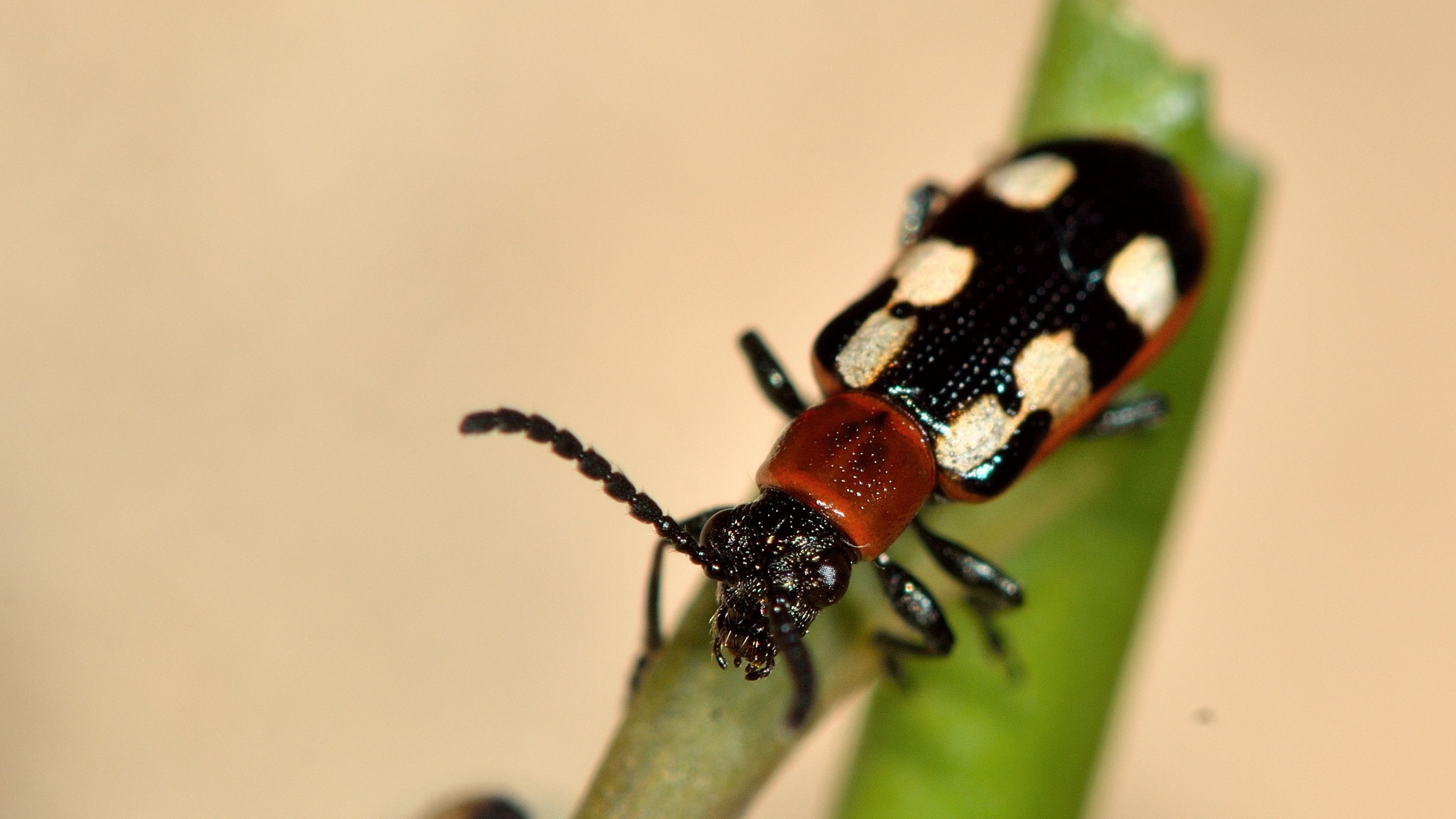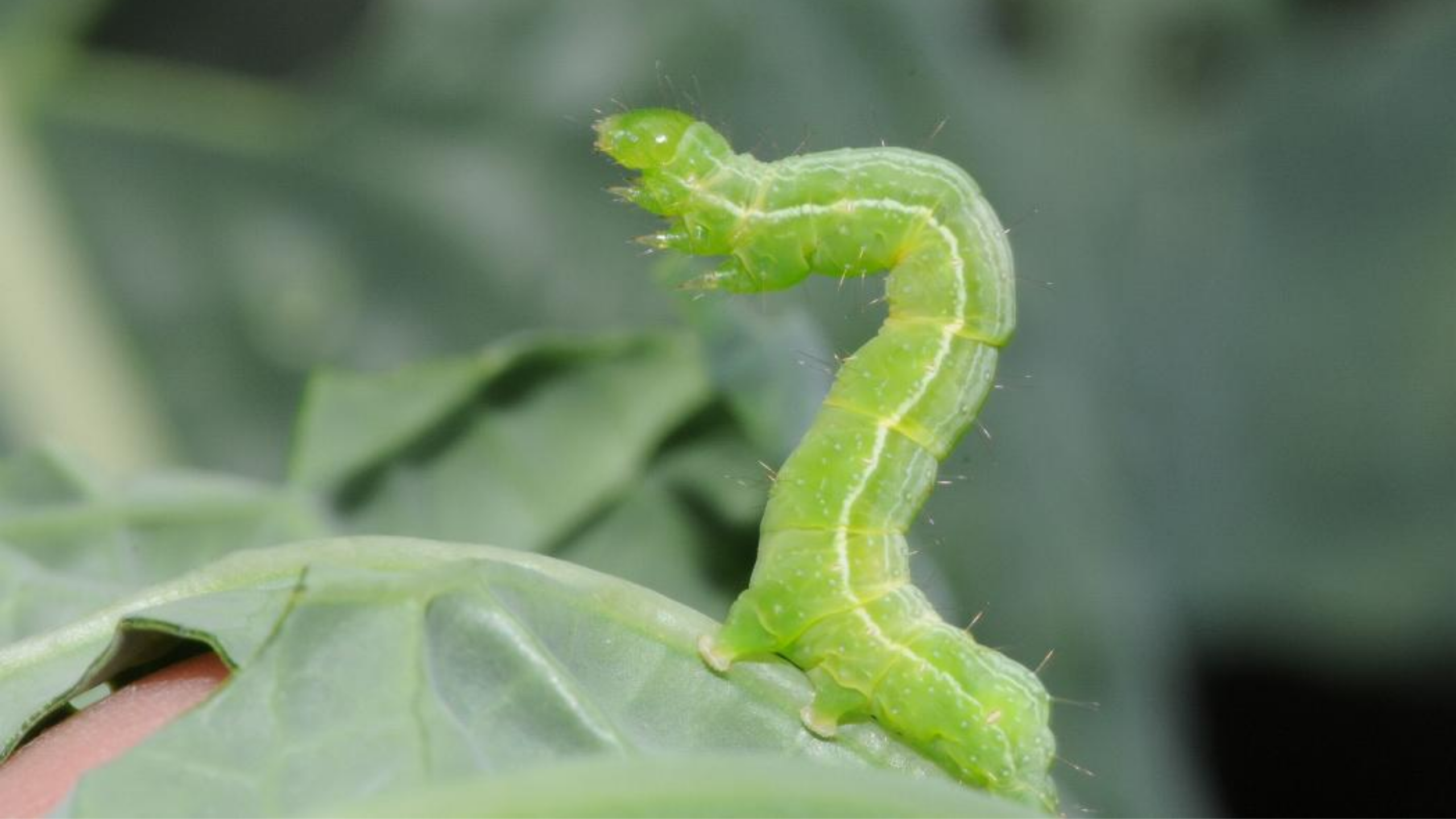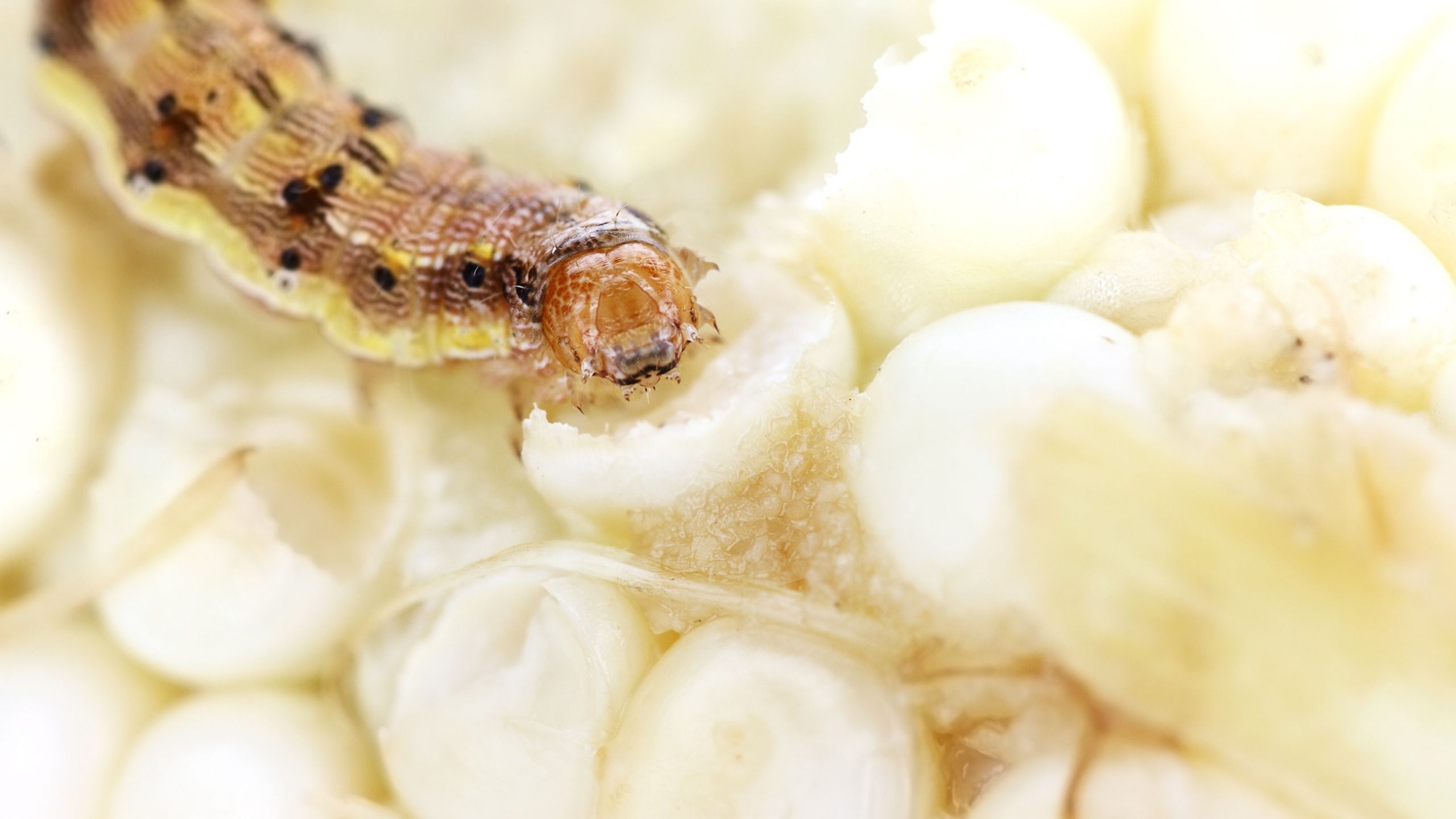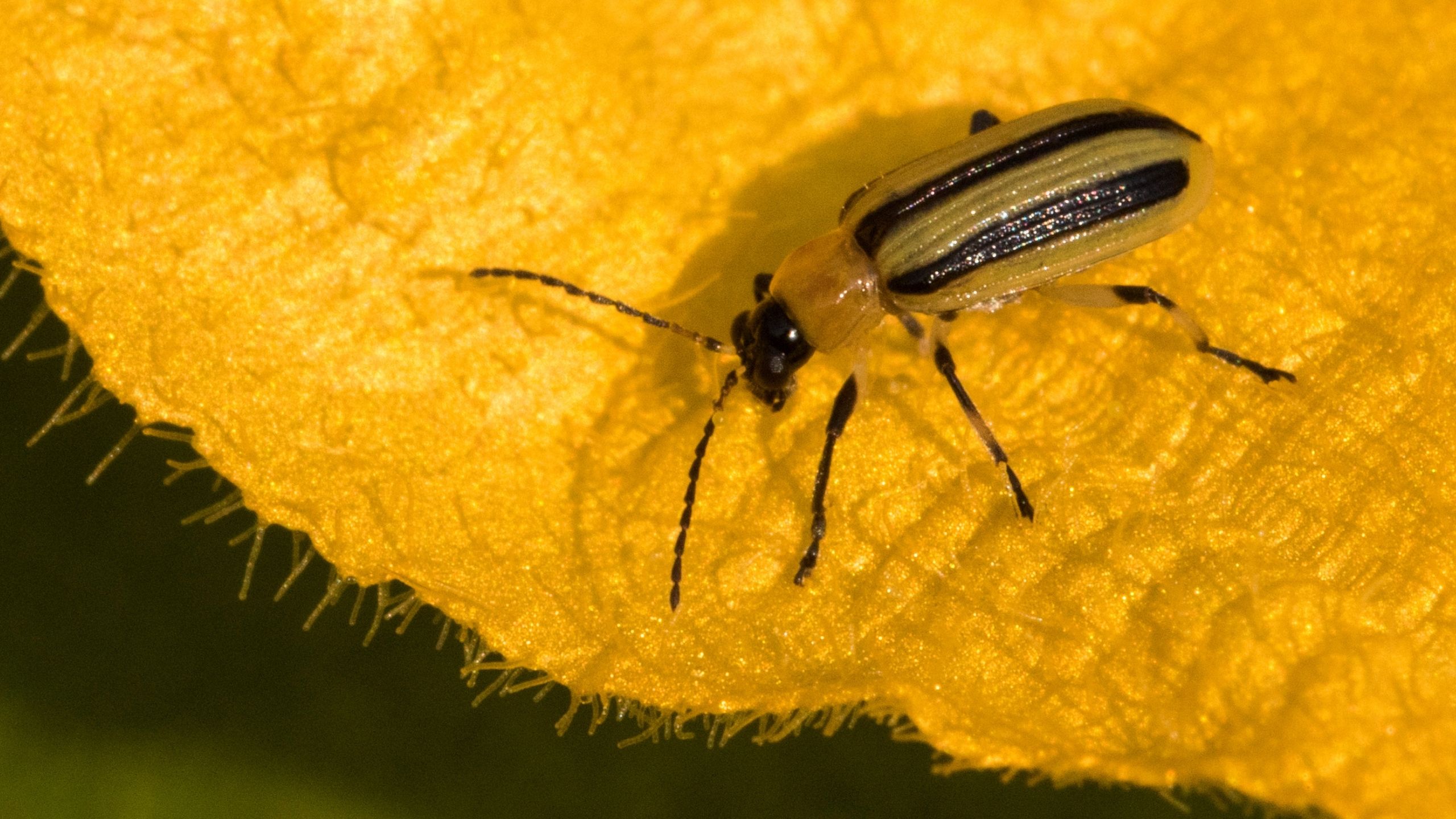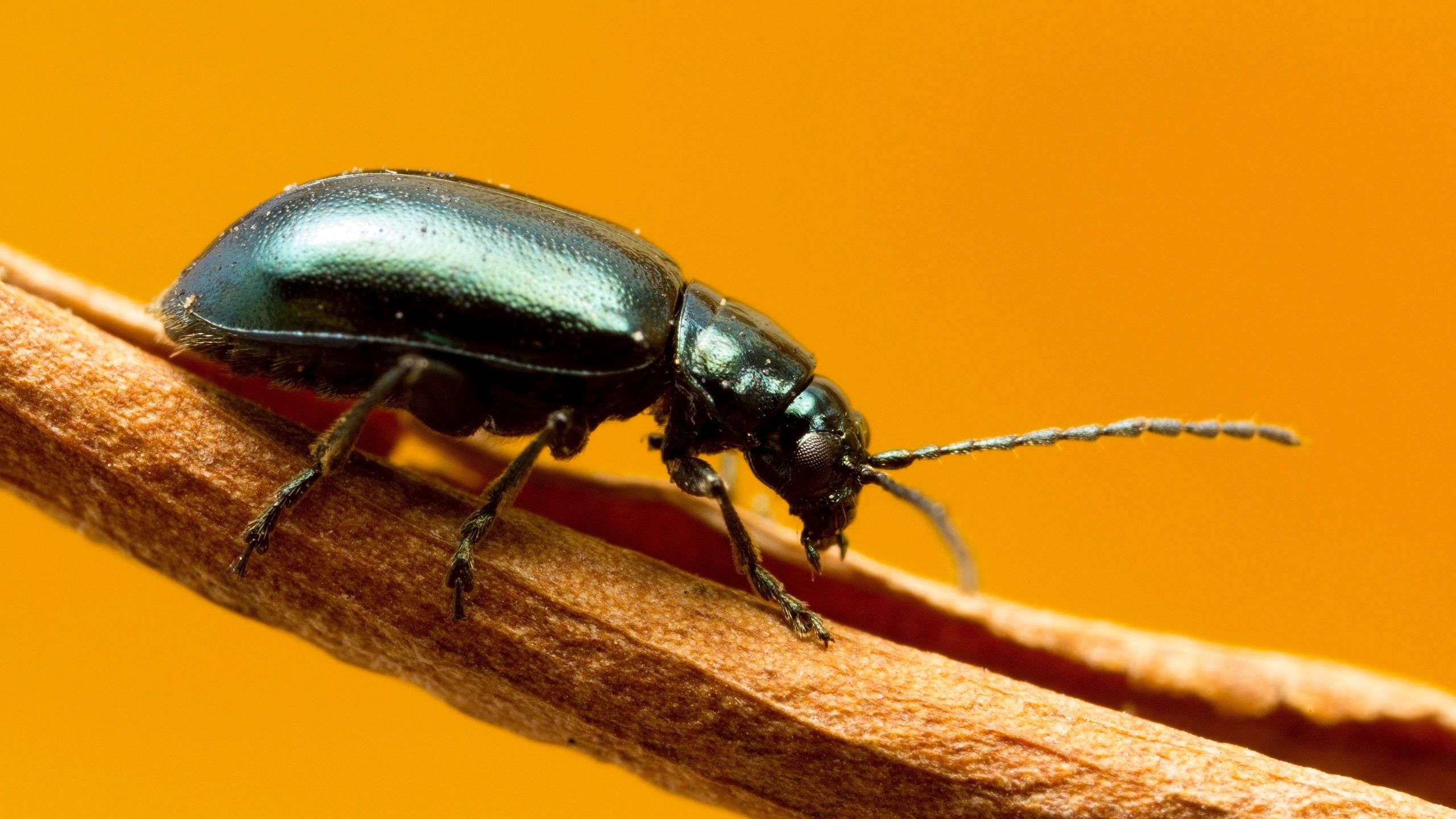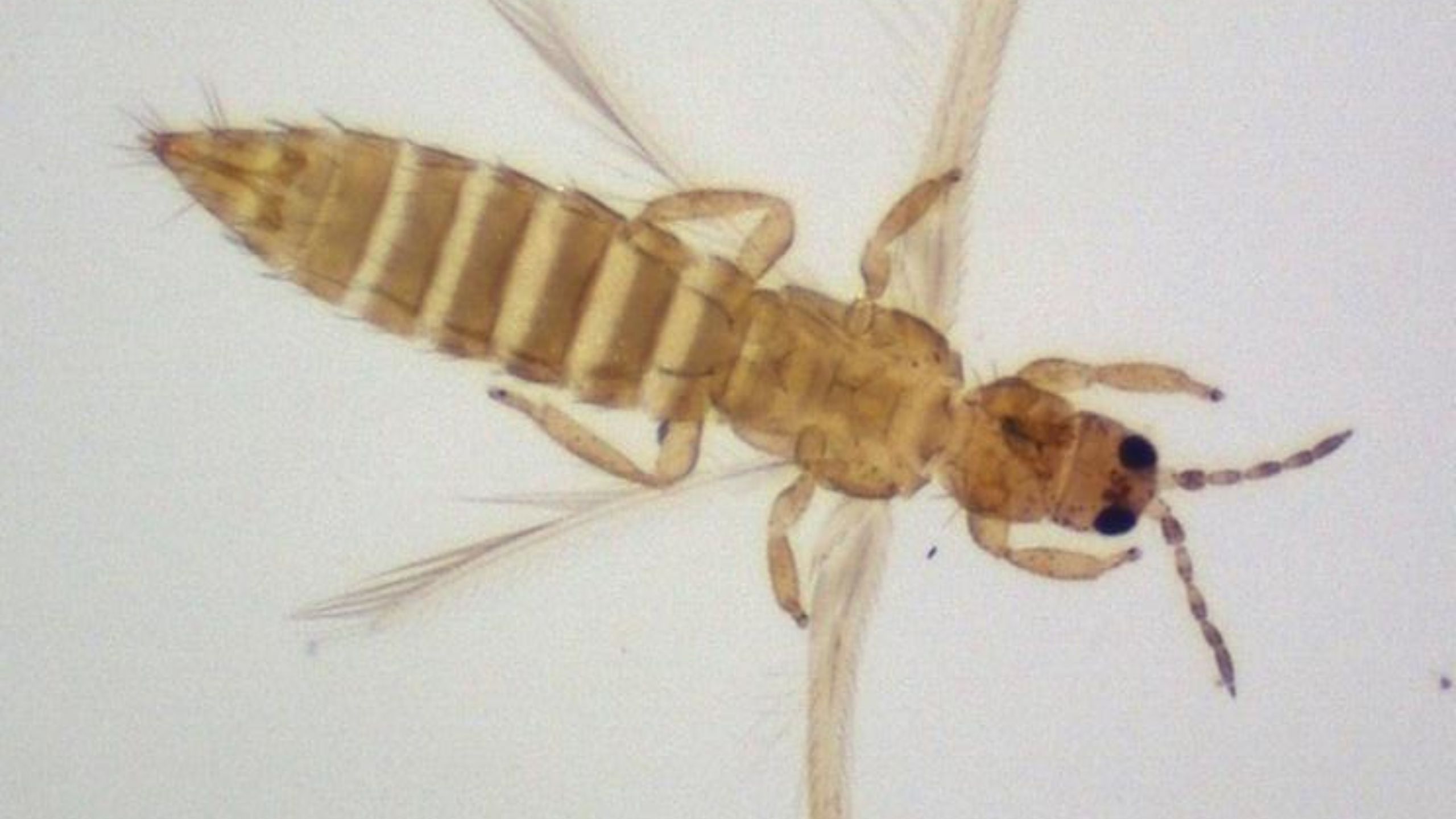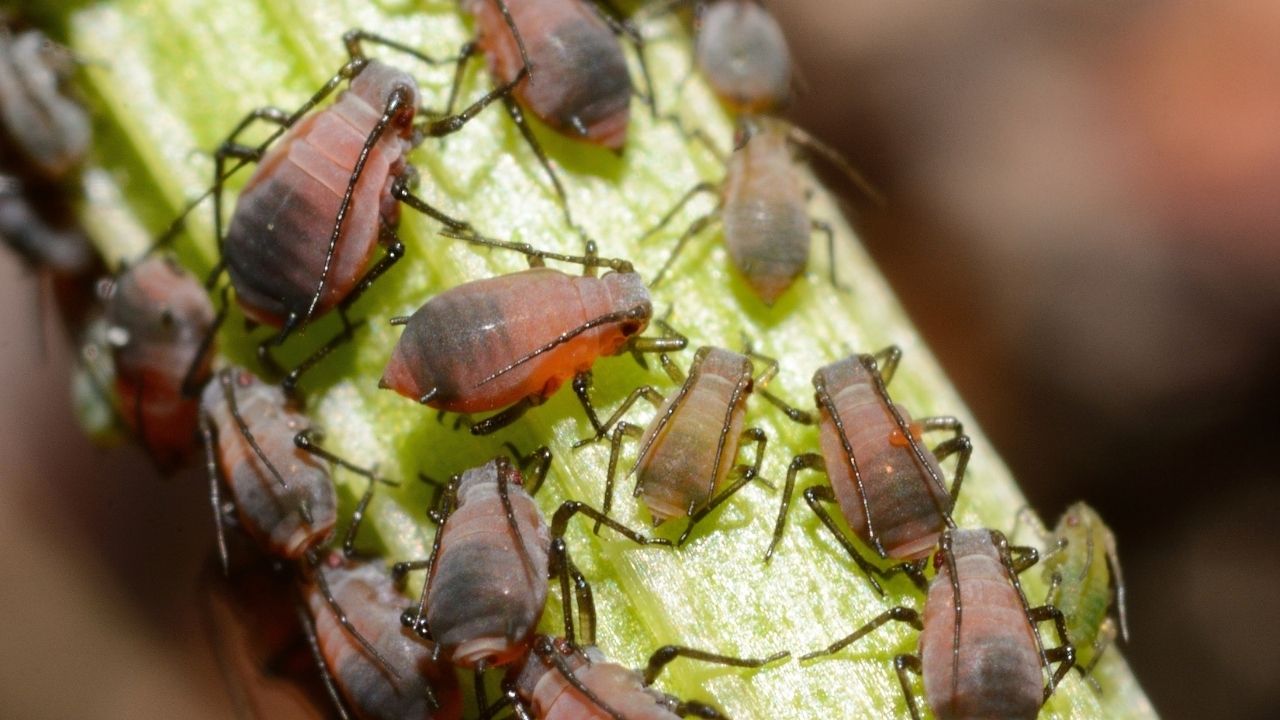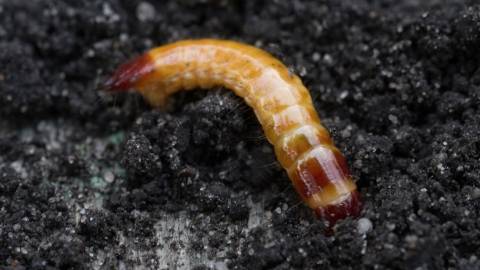Leafminers of Vegetable Crops
(Order: Diptera; Family: Agromyzidae)
July 2018
Diane Alston, Extension Entomologist (No longer at USU) • Ann Mull, Extension Assistant (No longer at USU)

Fig. 1. Leafminers puncture leaves to feed and lay eggs. Here, an adult female pea leafminer (L. huidobrensis) uses her ovipositor to puncture a potato leaf. Image courtesy of Weintraub, P. G., Scheffer, S. J., Visser, D., Valladares, G., Correa, A. S., Shepard, B. M., Rauf, A., Murphy, S. T., Mujica, N., MacVean, C., Kroschel, J., Kishinevsky, M., Joshi, R. C., Johansen, N. S., Hallett, R. H., Civelek, H. S., Chen, B., and Blanco Metzler, H. 2017. The invasive Liriomyza huidobrensis (Diptera: Agromyzidae): Understanding its pest status and management globally. Journal of Insect Science, Vol. 17 (1): 1-27.
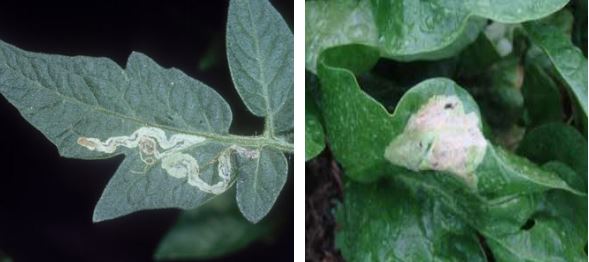
Fig. 2. Left: Mining from American serpentine leafminer (L. trifolii) on tomato. Right: Liriomyza spp. damage on Utah spinach. Image courtesy of James L. Castner, University of Florida (left image).
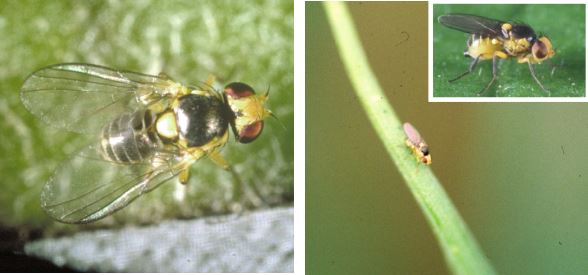
Fig. 3. Left: Adult American serpentine leafminer (L. trifolii). Right: Vegetable leafminer (L. sativae) adult on onion; Inset: L. sativae adult. Image courtesy of Central Science Lab, Harpenden, Bugwood.org (left image); Whitney Cranshaw, Bugwood.org (right image); Lyle J. Buss, University of Florida (inset).
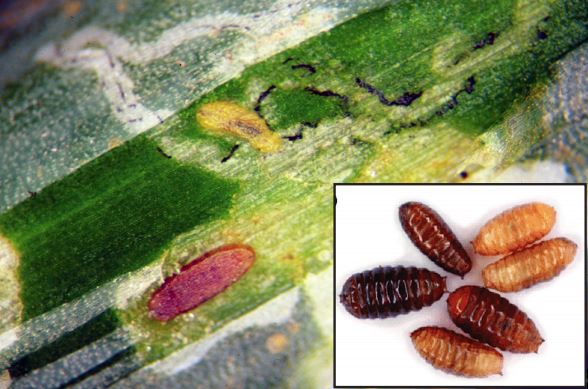
Fig. 4. Left: Multiple life stages of vegetable leafminer (L. sativae) on onion; Inset: Various aged and sized pea leafminer (L. huidobrensis) pupae. Image courtesy of Whitney Cranshaw, Bugwood.org (main image). Image courtesy of (inset) Weintraub, P. G., Scheffer, S. J., Visser, D., Valladares, G., Correa, A. S., Shepard, B. M., Rauf, A., Murphy, S. T., Mujica, N., MacVean, C., Kroschel, J., Kishinevsky, M., Joshi, R. C., Johansen, N. S., Hallett, R. H., Civelek, H. S., Chen, B., and Blanco Metzler, H. 2017. The invasive Liriomyza huidobrensis (Diptera: Agromyzidae): Understanding its pest status and management globally. Journal of Insect Science, Vol. 17 (1): 1-27.

Fig. 5. Mining from vegetable leafminer (Liriomyza sativae) on spinach. Image courtesy of Clemson University, USDA Cooperative Extension, Bugwood.org.
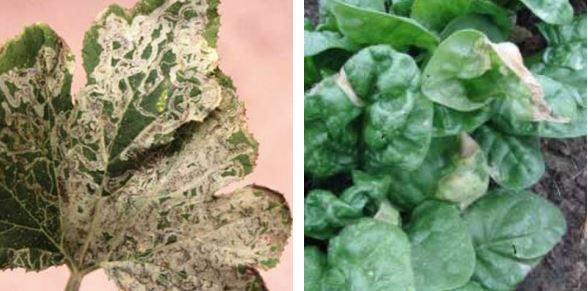
Fig. 6. Left: Severe mining on squash leaf by Liriomyza spp. Right: Typical Liriomyza spp. damage on Utah spinach. Image courtesy of James L. Castner, University of Florida (left image).

Fig. 7. Yellow sticky cards, whether purchased or homemade, can be beneficial in identifying the presence of leafminer flies. Image courtesy of Farmer Field Schools for IPM, ffs.ipm-info.org.

Fig. 8. Use a floating row cover with secured edges to deter leafminer activity. Image courtesy of Master Gardener Program, University of Wisconsin-Extension, wimastergardener.org.
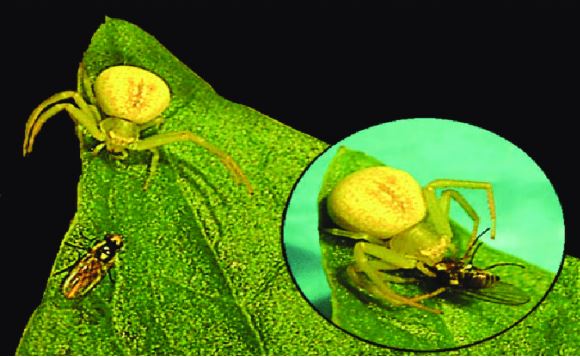
Fig. 9. Beneficial insects can play a key role in population control. Here, a crab spider (Family: Thomisidae) catches and consumes a pea leafminer (L. huidobrensis). Image courtesy of Weintraub, P. G., Scheffer, S. J., Visser, D., Valladares, G., Correa, A. S., Shepard, B. M., Rauf, A., Murphy, S. T., Mujica, N., MacVean, C., Kroschel, J., Kishinevsky, M., Joshi, R. C., Johansen, N. S., Hallett, R. H., Civelek, H. S., Chen, B., and Blanco Metzler, H. 2017. The invasive Liriomyza huidobrensis (Diptera: Agromyzidae): Understanding its pest status and management globally. Journal of Insect Science, Vol. 17 (1): 1-27.
Quick Facts
- “Leafminer” commonly describes the larval stage of various insects, but those that feed on vegetable crops are most commonly small yellow-and-black flies in the order Diptera.
- Vegetable host plants include leafy greens, beet, pea, tomato, onion, squash, and others.
- Leafminer larvae form visible tunnels as they feed within leaf tissue.
- Mining activity can affect the market value of vegetables harvested for edible foliage, such as spinach and chard.
- The American serpentine leafminer is a common leafminer in Utah whose name reflects its winding pattern of feeding.
- Using floating row covers, removing infested leaves, and conserving natural enemies can help control leafminer populations.
Agromyzid leafminers are pests of vegetable and ornamental crops throughout the world. In Utah, three species of leafminer flies attack vegetable crops: American serpentine leafminer [Liriomyza trifolii (Burgess)], pea leafminer [Liriomyza huidobrensis (Blanchard)], and vegetable leafminer [Liriomyza sativae (Blanchard)]. All three species are native to the New World (Western Hemisphere) but have spread worldwide. In the U.S., leafminers are most problematic in the southern states, from Florida to California, and Hawaii.
Hosts
American serpentine leafminer has a wide host range that includes bean, beet, carrot, celery, chard, cucumber, eggplant, lettuce, melon, onion, pea, pepper, potato, squash, tomato as well as ornamental flowers such as chrysanthemum, gerbera daisy, and marigold. Pea leafminer has an equally broad host range that includes broccoli, cauliflower, phlox, petunia, and viola in addition to many of the same hosts as the American serpentine leafminer. Vegetable leafminer feeds on many of the same plants as the other species, especially those in the cucurbit, legume, and solanaceous families. Allium leafminer [Phytomyza gymnostoma (Loew)], native to Europe, is a recent invasive pest to the northeastern U.S. that targets allium hosts both wild and cultivated (such as onion, leek, garlic, chive and shallot)
Description
Adult: Small fly less than 2 mm (0.08 in) in length with a wing length equal to or slightly longer than the body. Flies have yellow heads and grayish to black bodies with yellow markings on their underside. Wings are dark in color and held folded, horizontal over the back when at rest (Figs. 1 and 3).
Egg: White or yellowish, oval in shape, and 0.2-1.0 mm (0.01-0.04
in) in length.
Larva: Legless maggot that can be transparent immediately after hatching, changing to white or cream in color, and yellowing with age (Fig. 4). Oval or wedge-shaped body, 2-3 mm (0.08-0.12 in) in length. Mouthparts are typically dark in color. Two spiracles (breathing tubes) are present at the posterior end.
Pupa (Fig. 4): The pupa is enclosed within the last larval exoskeleton forming a smooth puparium. Color ranges from golden or reddish to dark brown, and length ranges from 1.5-3.5 mm (0.06-0.14 in). Two spiracles (breathing tubes) are visible on the posterior end.
Life History
Leafminers overwinter in the soil as pupae with adult flies emerging in the spring and summer. After mating, females use their ovipositor (egg-laying structure) to puncture the leaf surface to feed and lay eggs inside the leaf (Fig. 1). Eggs hatch quickly when temperatures are warm, usually within 2 to 4 days, and the developing larvae create visible winding mines as they feed below the leaf surface. Larvae pupate within the mines, on the underside of the leaf, or more typically, in the soil. Adults emerge after about 10 days during the summer months, returning above ground to feed and lay eggs. One generation takes 15 days to 1 month for completion; several generations occur each year.
Damage
Punctures from feeding and egg-laying appear as white stipples primarily on the upper surface of the leaf and can allow bacterial and fungal diseases to enter the plant. The major damage to the plant, however, is caused by the larva as it feeds and tunnels through the leaf’s mesophyll layer, resulting in blisters, blotchy mines, or serpentine tunneling (Figs. 5 and 6). The mine increases in size as the larva grows. Frass (feces) may be visible within mines and can contaminate leaves intended for human consumption. With heavy feeding damage, photosynthesis is reduced, and leaves may dry and drop, resulting in decreased plant quality and yield. The most serious infestations usually occur late in the season and can affect large areas of the leaf (Fig. 6). In Utah, vegetables show mainly cosmetic damage (Fig. 6). In warm areas and greenhouse production, damage may be more severe.
Monitoring
To detect and monitor adults, look for new stippling on leaves which indicates the presence of adult leafminers. Yellow sticky cards (Fig. 7) can be placed at plant height (mid to lower portion) and inspected at least twice per week. Sticky cards are available from a number of sources (see “Suppliers”) or made by using a 28x15 cm (11x6 in) yellow rigid 10-mil thick PVC sheet coated on one side with a tangle trap adhesive. Alternatively, a yellow bowl containing soapy water can be placed adjacent to an infested crop to monitor for adults. Counting mines in leaves with live larvae is time-consuming, but this provides an estimate of future damage potential. Counting the number of mines with dead larvae inside (not just old mines) can indicate the efficacy of insecticidal treatments or the success of biological control. For timing insecticidal sprays, action thresholds vary among crops: for tomato, three infested leaves or 0.7 larva per plant (Schuster 2006); for leafy greens, five percent of leaves infested is an effective threshold (University of Wisconsin 2018).
Management
Cultural Control
- Check transplants for signs of leaf mines and white stippling before planting; destroy infested plants.
- Clip and destroy infested leaves to prevent larval development.
- Plant a diversity of crops in a location, as monoculture plantings can be more susceptible to infestations.
- Place a floating row cover (lightweight plant fabric) (Fig. 8) over plants to inhibit adult flies from entering and laying eggs.
- Secure edges and ends of fabric for better protection. Note that this method is only effective when planting into a site not previously infested with leafminer pupae.
- Avoid excessive levels of nitrogen fertilization, as this can increase leafminer infestations.
- Remove plants near vegetable gardens and fields that are known to be leafminer hosts. These include weeds such as nightshade (Solanum americanum) and dock (Rumex obtusifolius), and ornamentals such as chrysanthemum, marigold, dahlia, gerbera, and gypsophila.
- Immediately after the final harvest, remove plants and deeply plow crop residues to remove food sources and inhibit pupal development.
- Rotate crop plantings.
- Use adequate irrigation to keep plants healthy and reduce stress.
Resistant Varieties: To date, minimal research has evaluated the tolerance of vegetable crops to leafminers. Crops such as tomato can withstand considerable leaf damage (an average of three mines per leaf) before yield reductions occur (Schuster et al. 1976). Tomato varieties with curled leaves (University of California 2008), high levels of foliar acylsugar (Silva et al. 2017), and varieties with shorter fruit maturation requirements typically have lower leafminer infestations. Cucumber varieties with high numbers of trichomes (hair-like outgrowths), such as ‘Gorgan’, ‘Sanandaj’ and ‘Roodbar’, have shown resistance to L. sativae (Basij et al. 2011). Similarly, leafminer resistance has been observed in spinach varieties with fewer leaf pores (Mou 2008). In field settings, broccoli and cauliflower with six or more leaves are rarely damaged by leafminers, regardless of leafminer populations (University of California 2007).
Biological Control
Many generalist predators attack leafminer adults and larvae. Ants, predatory wasps (such as yellow jackets and paper wasps), and
spiders have been shown to help suppress leafminer populations (Fig. 9). Parasitic wasps, such as Optus (Opius) dissitus and some eulophid wasps (Solenotus intermedius, Diglyphus spp. and Chrysocharis spp.), are also beneficial leafminer control agents.
These parasitoids pierce the soft body of a leafminer larva to deposit an egg. When the egg hatches, the developing parasitoid gradually consumes the leafminer larva. Leafminer outbreaks are usually associated with the repeated use of broad-spectrum insecticides that inadvertently kill such beneficial predators and parasitoids. Releasing the commercially available wasps Diglyphus isaea and Dacnusa sibirica has been part of a successful integrated pest management (IPM) program in greenhouses (Roques 2006). Nematodes can assist in IPM control of many pests, but current research suggests they are impractical for controlling leafminers.
Chemical Control
The primary target of insecticides is the sap-feeding larva. Since larvae are protected within the leaf, insecticides that penetrate
the leaf (translaminar activity) are most effective. Adjuvants and surfactants that increase insecticide adherence to the leaf tissue
may improve efficacy of the insecticide. In locations with intense vegetable production, such as in California and Florida, resistance in leafminer populations to insecticides is common.
Chemical recommendations (by chemical class) for leafminer control in Utah:
- Abamectins: abamectin (Agri-Mek)
- Spinosyns: spinosad [Success, Entrust (organic)] and spinetoram (Radiant).
- Pyrethroids: gamma-cyhalothrin (Declare), lambda-cyhalothrin (Warrior), permethrin (Ambush, Pounce), pyrethrin [Pyganic (organic)]
- Neem: adadirachtin [Aza-Direct, Azatin (organic)]
- Insecticidal soap: M-Pede, Safer’s (organic)
- Oils: horticultural oil (many brands), plant oils (peppermint, rosemary) (organic)
To conserve natural enemies, only apply insecticides when essential. Be aware that broad-spectrum insecticides, such as
pyrethroids, abamectins and spinosyns can kill bees. Carefully read all product labels, and only apply when risk to bees is low. The combination of multiple management strategies, known as integrated pest management (IPM), is the preferred approach to achieving long-term control of leafminers. Implement both cultural and biological control practices, and supplement, based upon the action threshold, with occasional applications of less-toxic insecticides as needed. When chemicals are used, rotate among classes, as frequent applications of same-class, higher-toxicity insecticides are more likely to have the undesirable result of breeding resistant leafminer populations.
The Allium Leafminer
Native to Europe and a recent invasive pest to the U.S., the allium leafminer [Phytomyza gymnostoma (Loew)] (Fig. 10, above) is a reportable species currently known only in PA, NY, and NJ. Plants in the Allium genus are affected, including leek, onion, garlic, chive, shallot, green onion, and ornamental species, with damage that can result in stunted growth, wilting, and curled and distorted leaves (Fig. 11). Compared to the known Utah leafminers described in this fact sheet, the allium leafminer adult fly is similar in size [3 mm (1/8 in)], but its larvae are almost
twice as long [8 mm (1/3 in)]. The adult fly feeds and lays eggs in a line, creating a white trail of small punctures in the leaf (Fig. 12). The developing larvae mine the leaves, eventually moving down to pupate in the leaf sheaths or bulb (Fig. 12). High rates of infestation can occur, with 20 to 100 pupae developing per plant. Two generations occur per year; the second generation overwinters as pupae in the soil. Continuous cultivation of Allium species provides a continuous food source for the pest. Suspect allium leafminers should be sent to the Utah Plant Pest Diagnostic Lab at Utah State University or the Insect Control Program of the Utah Department of Agriculture and Food. Place specimens into a vial containing rubbing alcohol (white vinegar or hand sanitizer are suitable alternatives) and secure using packing material to avoid damage.

Image courtesy of Lawrence Barringer, Pennsylvania Dept. of Agriculture, Bugwood.org
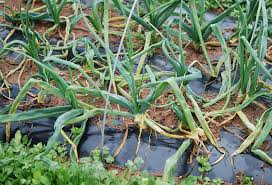
Image courtesy of Lawrence Barringer, Pennsylvania Dept. of Agriculture, Bugwood.org
Further Reading and References
- Alston, D., and Bunn, B. 2016. Utah vegetable production and pest management guide: Leafminers. Utah State Univ Extension.
- Basij, M., Askarianzaeh, A., Asgari, S., Moharramipou, S., and Rafezi, R. 2011. Evaluation of resistance of cucumber cultivars to the vegetable leafminer (Liriomyza sativae Blanchard) (Dipera: Agromyzidae) in greenhouse. Chilean J. of Ag. Research. 71(3) pp. 395-400.
- Capinera, J.L. 2001 (revised 6/2017). Featured creatures: American serpentine leafminer. Univ of Florida.
- Fleischer, S., and Elkner, T. 2016. Pest alert: Allium leafminer. Pennsylvania State Univ.
Mou, B. 2008. Leafminer resistance in spinach. Hort Science 43(6): 1716-1719. - Roques, A. 2006. Liriomyza huidobrensis. DAISE. N.p.
- Schuster, D.J. 2006. “Pest Management.” University of Florida Institute of Food and Agricultural Sciences. University of Florida, n.d. Web 19 Feb 2013.
- Schuster D.J., Jones J.P., and Everett P.H. 1976. Effect of leafminer control on tomato yield. Proceedings of the Florida State Horticultural Society 89: 154-156.
- Silva, A.A. da, Andrade M.C., Maluf, W.R., Moraes, J.C., and Rezende, J.F. 2017. Resistance of tomato plant genotypes with high foliar allelochemical contents to the leafminer Liriomyza trifolii. Arq. Inst. Biol. Vol 84, e0892015.
- University of California. 2007 (revised 9/2009). UC pest management guidelines: Cole crops. Univ of California.
- University of California. 2008 (revised 9/2016). UC pest mangement guidelines: Tomato. Univ of California.
- University of Wisconsin. 2018. Vegetable crop entomology: Vegetable leafminers. Univ of Wisconsin-Madison Extension.
Related Research


